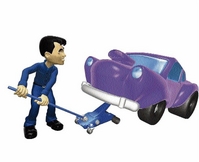
CooLing systems are important for the efficient working of any vehicle. Experts advise that owners do a thorough pressure test of cooling systems both before and after any repairs.
"The cooling-system hoses should be checked frequently," said Andrew Brown, auto mechanic.
"They [hoses] should be examined for cracks, softness and brittleness," he continued.
Most cars have four or five cooling-system hoses. However, two are radiator hoses. One delivers coolant to the engine, while the other transfers hot coolant from the engine to the radiator. The two hoses that transfer coolant to and from the heater are also part of the cooling system. There may be a bypass hose from the water pump to the engine.
"Hoses are important to engine operation," says Brown who has 30 years of experience.
"If a hose is leaking ... coolant to be lost and you may be stranded since an engine without coolant will overheat and seize," he says.
According to Brown, preventative maintenance is the way to go, however, travelling with duct tape in the event of an emergency cannot be discounted. He advised that some car manufacturers recommend all hoses be replaced every two years.
Always inspect the hoses
Examine the hoses for cracks, softness and being brittle by squeezing along its length. It should be resilient and flexible.
If cracks appear while squeezing, replace it. With the engine running, check hoses for bulges.
A bulge signals that a hose is weak and likely to break. Therefore, have someone racing the engine as you examine the radiator hose. If it flattens, the spring inside the hose is weak. This too means that the hose has to be replaced since coolant flow is inhibited. A collapsed lower radiator hose leads to overheating.
Please remember when checking the lower radiator hose, keep hands away from the fan, belts and pulley. Do not wear loose clothes. Now, as you check each hose, examine its clamps for coolant leakage. If a clamp is loose, tighten it; if distorted, replace it.
- Paul Messam
How to replace the hose
To avoid injuring yourself, replace hoses when engine is cold.
1 Drain coolant below the level of the hose being replaced. If coolant is to be reused, drain it into a clean container.
To avoid losing any coolant, push a length of clean hose over the radiator petcock (valve) and place the other end in a container.
2 Open the hose clamps, or cut them off if they are going to be replaced.
3 Pull the old hose off its connectors by twisting and pulling. If the hose is fastened, slit with a utility knife and unfasten.
4 Clean the metal connectors with a wire brush or emery cloth.
5 Slip clamps on to the new hose and push the hose back on to its connectors. If the hose is tight and does not slide home, soak end in hot water.
6 When the hose is seated, position clamps about 1/4 inch from the ends of the hose and tighten the clamps.
7 Pour coolant back into the radiator. Start the engine and let it run as you examine that system for leaks.